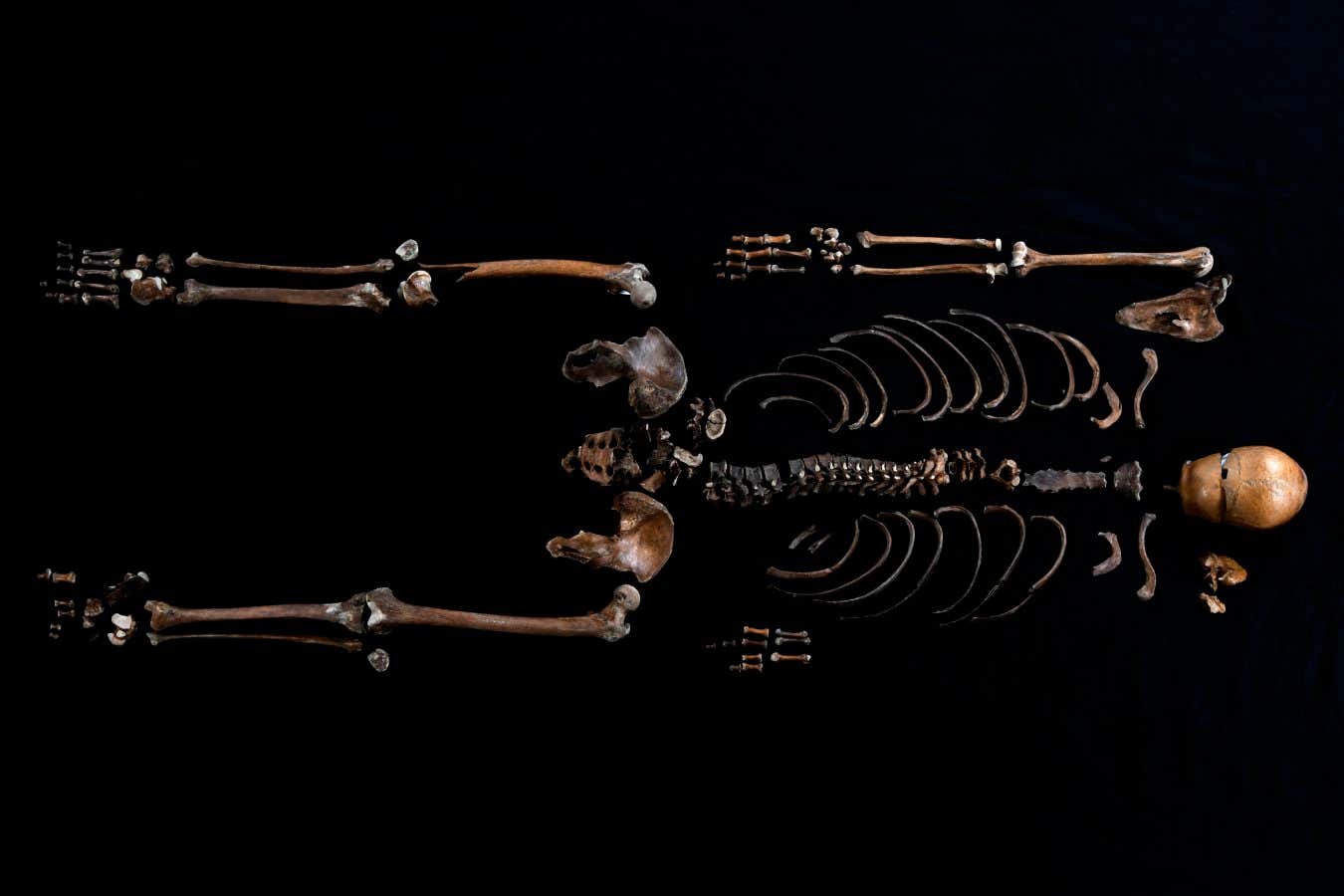
The complete skeletal remains of the “Well Man”
Age Hojem, NTNU University Museum
A Norwegian saga written more than 800 years ago describes how a dead man was thrown into a castle well – and now, researchers believe they have identified the remains of this man.
The Sverris saga is an 182-verse Old Norse text that records the exploits of King Sverre Sigurdsson, who rose to power in the second half of the 12th century AD. One part says that a rival clan who attacked Sverresborg castle, near Trondheim, Norway, “took a dead man and cast him unto the well, and then filled it up with stones”.
The well was inside the castle’s ramparts and was the community’s only permanent water source. It has been speculated that the man thrown into the well in the saga may have had a disease and putting him there was an early act of biological warfare.
In 1938, a medieval well in the ruins of Sverresborg castle was partly drained and a skeleton was found beneath rubble and boulders at the bottom. While it was widely believed that the skeleton, referred to as Well Man, was the remains of the individual mentioned in the saga, it wasn’t possible to confirm this at the time.
Now, Anna Petersén at the Norwegian Institute of Cultural Heritage Research in Oslo and her colleagues have used radiocarbon dating and DNA analysis of a tooth from the body to show that the date range the man was alive is consistent with the raid on the castle. While not definitive proof that the man was the one mentioned in the saga, the “circumstantial evidence is consistent with this conclusion”, says Perersén.

The Well Man skeleton was discovered in 1938
Riksantikvaren (The Norwegian Directorate for Cultural Heritage)
What is more, the team has been able to add to the story. “The research we have done has shown many details concerning both the event and the man that the saga episode doesn’t mention,” says Petersén.
For example, the DNA suggests he most likely had blue eyes and blond or light-brown hair. The researchers also believe his ancestors were from what is now Vest-Agder, the southernmost Norwegian county, based on comparisons with the DNA of modern and ancient Norwegians.
One thing they couldn’t find was any evidence that the man was thrown into the well because he had a disease or to render the drinking water unusable, but they also found no evidence against it, leaving the question unanswered.
Michael Martin at the Norwegian University of Science and Technology in Trondheim says the team’s approach of matching historical documents with DNA evidence could also be applied to construct family trees of long-dead royal families or to “physically describe and sketch out the life stories, such as movement between geographic regions, of the otherwise anonymous people whose remains are recovered from archaeological excavations”.

Researchers took DNA from one of the skeleton’s teeth
Norwegian Institute for Cultural Heritage Research (NIKU)
“This is, to my knowledge, the oldest case where genomic information has been recovered from a specific character, or even a specific person, mentioned in an ancient text,” says Martin.
He says by generating genomic information from ancient skeletal remains, we can provide new details about a person. “These details are not in the original text, thus the genetic data enriches the story and provides a way to separate fact from fiction,” says Martin.
Topics:

Felecia Phillips Ollie DD (h.c.) is the inspiring leader and founder of The Equality Network LLC (TEN). With a background in coaching, travel, and a career in news, Felecia brings a unique perspective to promoting diversity and inclusion. Holding a Bachelor’s Degree in English/Communications, she is passionate about creating a more inclusive future. From graduating from Mississippi Valley State University to leading initiatives like the Washington State Department of Ecology’s Equal Employment Opportunity Program, Felecia is dedicated to making a positive impact. Join her journey on our blog as she shares insights and leads the charge for equity through The Equality Network.




